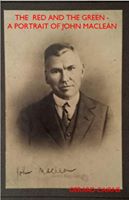Gerry Cairns has published a new book, The Red and the Green: A Portrait of John Maclean. This makes use of new material relating to Maclean’s relationship with the struggle in Ireland. Stevie Coyle posted the following review on Facebook, and there is an edited version in February’s Irish Voice. Hopefully this informative review will be just the first review to address the issues that Gerry has raised.
THE RED AND THE GREEN: A PORTRAIT OF JOHN MACLEAN
Members of the Irish community were among those present at the launch of Gerard Cairn’s biography of John Maclean titled The Red and the Green: A Portrait of John Maclean.
The event – organised by Glasgow’s radical bookshop Calton Books and held in McChuills Bar – saw the author demonstrate a passion for his subject and gave an intriguing insight into Maclean the man and the revolutionary, which he interspersed with humour.
Cairns is a former Secretary of the John Maclean Society and an expert on the Scottish revolutionary, and this new biography is a brilliant addition to the scholarship on Maclean, properly locating Maclean in his historical, political and cultural context and reviving the warm, complex man behind the icon.
John Maclean who was born in 1879 in Pollokshaws was a schoolteacher and convert to Marxism having had a Calvinist upbringing. Due to his principled opposition to the carnage of the First World War which he labelled an imperialist war, Maclean was arrested under the Defence of the Realm Act and lost his teaching post. He famously stated that “a bayonet is a weapon with a worker at both ends.” He then became a full-time Marxist lecturer and organiser. His greatest crime in the eyes of the British establishment was the teaching of Marxist economics to the working classes, who are reported to have attended his classes in large numbers. In April 1918 he was arrested for sedition, and his 75-minute speech from the dock became a celebrated text for Scottish revolutionaries. He famously thundered that ‘I am not here, then, as the accused; I am here as the accuser of capitalism dripping with blood from head to foot.’ Maclean was recently appointed as Soviet Consul for Scotland by the Bolsheviks. He was given a harsh sentence of five years’ penal servitude, but was released after the November armistice.
An important aspect of Maclean’s political stand was his support for the struggle for Irish freedom. He was undoubtedly influenced by Joe Robinson who was head of the Irish Republican Army in Scotland, and veteran of the Easter Rising Barney Friel, both of whom were incarcerated at the same time as him in Peterhead Prison in 1918. When Maclean was released from prison he continued his links with members of the Scottish Brigade of the IRA on Clydeside, and used his contacts among the miners in Lanarkshire to secure a plentiful supply of explosives and detonators which were smuggled to Ireland to boost the republican war effort.
He was also to the fore in publicity work in support of the Irish cause and was particularly concerned about the involvement of Scottish regiments of the British army in the suppression of the Irish people. He produced a pamphlet in 1920 titled The Irish Tragedy: Scotland’s Disgrace which sold 20,000 copies and organised a ‘Hands Off Ireland’ Campaign which held huge rallies throughout the industrial areas of Scotland.
Maclean’s understanding of the Irish struggle combined with the profound influence that members of the Scots National League had on him – like Ruaraidh Erskine of Mar – a firm supporter of the Irish struggle, convinced him that the break-up of the British state and empire would aid the cause of worldwide socialism. Like James Connolly – whom Maclean greatly admired – he reached the conclusion that the cause of national independence and the cause of socialism were inseparable. He refused to join the Communist Party of Great Britain when it was founded in 1920 and instead declared his support for a Scottish workers’ republic and founded the Scottish Workers’ Republican Party to campaign for it.
When John Maclean died of pneumonia on St Andrew’s Day 1923, more than 10,000 people followed the funeral procession to Eastwood Cemetery. The Irish in Scotland had not forgotten the practical assistance he gave to their cause. The Irish republican movement sent representatives to the funeral and among the messages of sympathy extended to his widow Agnes, was a message from Sinn Féin in Glasgow and another from Captain Robert De Coueur on behalf of the Irish Citizen Army.
Following a Q&A the author appropriately concluded his book launch with a rousing rendition of The John Maclean March written by Hamish Henderson.
The Red and the Green: A Portrait of John Maclean by Gerard Cairns is available from Calton Books price £6.99.
Stephen Coyle
(An edited version of the review appeared in the February edition of The Irish Voice).
_________
For other some pieces on this blog relating to John Maclean see:-

